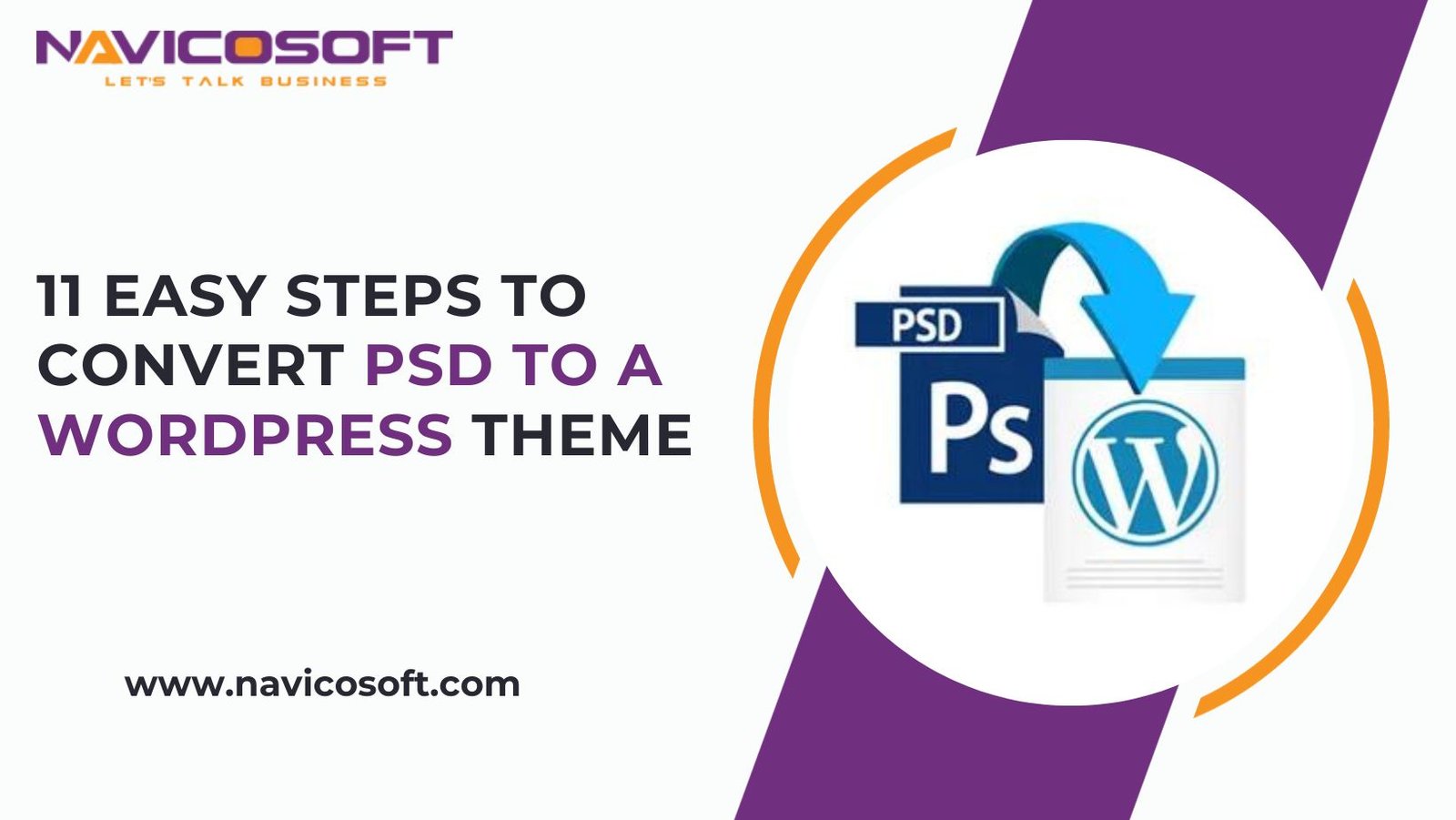
PSD and WordPress are two distinct terms related to the design and development part of the website. Each of them is important for website development and plays a key role.
However, given the need for websites, PSD to WordPress services and experts are also highly in-demand tools of this digital era.
Let this blog explore easy steps to convert PSD to a WordPress theme with this guide. Before that, let's discuss the basic fundaments of PSD and WordPress, i.e.:
PSD (Photoshop Document):
- PSD stands for "Photoshop Document," and it is a file format used by Adobe Photoshop, a popular graphic design software.PSD files are typically created when designing website layouts, graphics, logos, and other visual elements.
- PSD files are versatile and allow designers to work with layers. That means that different parts of the design (such as text, images, and shapes) can be edited independently.This, as a result, makes it easier to create and modify complex designs.
- Designers often use PSD files to create mockups and prototypes of websites before the actual development process begins. Once a design is finalized in Photoshop, it can be converted into a web-ready format for implementation.
WordPress:
- WordPress is a powerful and widely used open-source content management system (CMS) and blogging platform written in PHP. In addition, it uses a MySQL database to store website content.
- WordPress lets users easily create, manage, and publish website content without extensive technical knowledge. It offers a user-friendly interface alongside a vast array library of themes and plugins. With its popularity, it undoubtedly has a strong community of developers and users.
- WordPress is highly customizable and supports various types of websites, including blogs, e-commerce stores, portfolios, business websites, and more. Users can choose from numerous themes and plugins if they want to extend the functionality and appearance of their websites.
- Another one of the key features of WordPress is its theme system. That allows users to change the design and layout of their websites. It's easy to create the themes from scratch or purchase and customize them to suit specific design preferences and branding.
Converting the PSD to a WordPress theme
In this context, "converting a PSD to WordPress theme" describes the process of taking a website design created in Adobe Photoshop (in PSD format) and transforming it into a functional and interactive website using the WordPress platform.
You must complete this process in various measurable steps to convert PSD to a WordPress theme (one file into another).
Therefore, this conversion process requires coding the design into HTML, CSS, and PHP to create a WordPress theme that you can install and use on a WordPress website.
This way, you can bring the design created in Photoshop to life on the web using WordPress's content management and publishing capabilities.
Converting a PSD (Photoshop Document) into a WordPress theme is crucial in bringing your web design to life.
WordPress, indeed, is a powerful content management system that empowers you to easily create dynamic websites.
This guide will guide you through the process of transforming your PSD file into a functional and responsive WordPress theme, ensuring that your website looks great and functions seamlessly.
Steps to Make the Conversion
Follow these easy steps to make the conversion process smooth and efficient. The most important steps include:
- Slice your PSD
- Create the necessary HTML and CSS files
- Breakdown the HTML file
- Integrate WordPress tags
- Add functionalities with WordPress loop
- Test in various browsers
- Make it responsive
- Integrate WordPress plugins
- Validate your theme
- Test on a local server
- Final and upload
Let's explore the above-mentioned steps to convert PSD to a WordPress theme in depth.
-
Slice your PSD
The first of many basic steps to convert is, when you open your PSD in Photoshop, you're essentially looking at the blueprint for your website.
Slicing helps you break down this blueprint into usable chunks. When you slice, focus on segregating the design into its core visual components like headers, footers, and sidebars.
The accuracy of your slices determines the seamlessness of your final theme. Ensure each section is saved with relevant naming to avoid confusion later.
-
Create the necessary HTML and CSS files
Secondly, the transition from a visual design in Photoshop to a coded structure starts here. The HTML file provides the basic skeleton for your website.
As you integrate the sliced images into this file, remember that the positioning, margins, and padding should be precise to ensure your theme looks identical to your PSD design.
The accompanying CSS file will handle your site's aesthetics, from colors and fonts to responsive behavior.
-
Break down the HTML file
Thirdly, this step involves segmenting the HTML to fit into WordPress's modular PHP structure. Each section of the site - be it header, footer, or sidebar - will get its own PHP file.
This breakdown facilitates easier modifications in the future and ensures smooth integration with WordPress.
-
Integrate WordPress tags
By using WordPress tags, you're giving dynamic life to your static HTML structure. Further, these tags pull real-time content from your database, ensuring fresh content every time a user visits.
So, take some time to understand and use the appropriate tags to ensure content alignment and proper fetching.
-
Add functionalities with WordPress loop
Also, the heart of every WordPress site is the Loop. It ensures that your theme consistently retrieves and displays content, from blog posts to news updates.
Without the Loop, your theme remains static and fails to showcase your latest content.
-
Test in various browsers
Indeed, in this digital age, users access websites via an array of browsers. Even minor differences in browser rendering can affect user experience.
By testing in multiple browsers, you guarantee a consistent and user-friendly experience for all visitors, regardless of their browser choice.
-
Make it responsive
Undoubtedly, mobile internet usage has skyrocketed. A theme that looks gorgeous on desktop but clunky on mobile will lose visitors.
Implementing media queries ensures your theme gracefully adjusts to any screen size, ensuring visitors get the best experience, whether they're on a laptop, tablet, or phone.
With the accelerating use of mobile devices, ensuring that your WordPress theme is mobile-responsive is essential.
Use media queries and responsive design techniques to adapt your layout to various screen sizes and orientations.
-
Integrate WordPress plugins
Also, plugins are the magic wands of the WordPress ecosystem. They instantly bestow your site with added functionalities.
While choosing plugins, prioritize those that align with your website's goal and enhance user experience without overloading the backend.
-
Validate your theme
Ensuring that your theme aligns with modern web standards isn't just about professionalism but performance. A validated theme runs smoother, loads faster, and provides a better user experience.
-
Test on a local server
Before showcasing your theme to the world, it deserves a dry run. By testing on a local server, you mimic the live environment, catch potential errors, and make necessary tweaks, ensuring the live deployment is smooth and hiccup-free.
-
Finalize and upload
Lastly, your theme's journey from a PSD file to a live WordPress site is almost complete.
Ensure you've double-checked every detail, from visual alignment to backend functionalities, before hitting the upload button.
And once it's live, take a moment to appreciate your hard work and creativity!
Once you've completed all the steps and thoroughly tested your WordPress theme, perform a final review.
Check for any remaining issues and ensure that your website's design and functionality meet your expectations. When you're satisfied, it's time to launch your WordPress theme.
Conclusion
Converting PSD into WordPress might appear to be a complex process. However, it can help create a stunning, functional, and responsive website.
So, by following these simple steps to convert PSD to a WordPress expert theme, one can have a dream website standing out on the web.
Give careful attention and care to each stage of the PSD to WordPress theme conversion because every step holds its significance.
Getting help from a PSD to WordPress expert is feasible. Experts can breathe life into your design vision and ensure a reliable, user-friendly website that withstands the test of time.
Original Source: https://timesofrising.com/11-easy-steps-to-convert-psd-to-a-wordpress-theme/


No comments yet